
The Constitution of Japan is the constitution of Japan and the supreme law in the state. It was written primarily by American civilian officials working under the Allied occupation of Japan after World War II. The current Japanese constitution was promulgated as an amendment of the Meiji Constitution of 1890 on 3 November 1946 when it came into effect on 3 May 1947.

Baron Tanaka Giichi was a general in the Imperial Japanese Army, politician, cabinet minister, and the Prime Minister of Japan from 1927 to 1929.
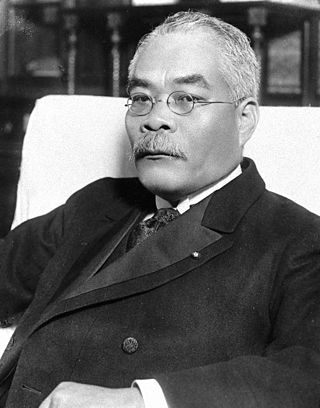
Hamaguchi Osachi was a Japanese politician, cabinet minister and Prime Minister of Japan from 1929 to 1931. Nicknamed the "Lion Prime Minister" due to his dignified demeanor and mane-like hair, Hamaguchi served as leading member of the liberal Rikken Minseitō during the "Taishō democracy" of interwar Japan. He was a member of the House of Representatives from 1915 until his death. He initially survived an assassination attempt by a right-wing extremist in 1930, but died about nine months later from a bacterial infection in his unhealed wounds.
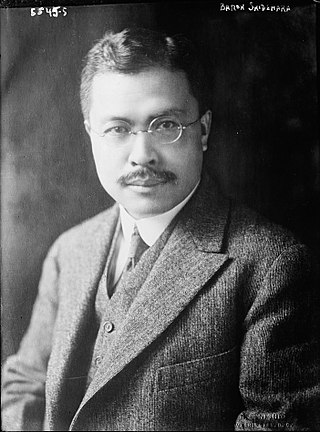
Baron Kijūrō Shidehara was a pre–World War II Japanese diplomat and politician. He was prime minister of Japan from 1945 to 1946 and a leading proponent of pacifism in Japan before and after World War II. He was the last Japanese Prime Minister who was a member of the peerage (kazoku). His wife, Masako, was the fourth daughter of Iwasaki Yatarō, founder of the Mitsubishi zaibatsu.
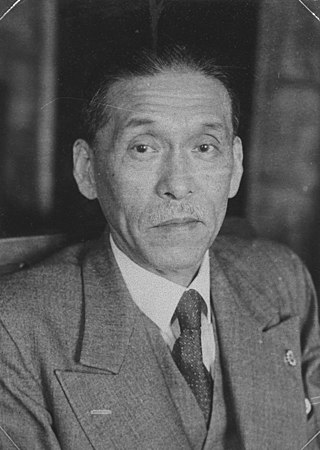
Hitoshi Ashida was a Japanese politician who served as Prime Minister of Japan in 1948. He was a prominent figure in the immediate postwar political landscape, but was forced to resign his leadership responsibilities after a corruption scandal targeting two of his cabinet ministers.
The Humanity Declaration is an imperial rescript issued by Hirohito, the emperor of Japan, as part of a New Year's statement on 1 January 1946 at the request of the Supreme Commander for the Allied Powers. In the rescript, which started with his citation of the Five Charter Oath of 1868, the Emperor denied the concept of his divinity, which would eventually lead to the promulgation of the new Constitution, under which the Emperor is "the symbol of the State and of the unity of the people".

The Tōyō Bunko (東洋文庫), or Oriental Library, is Japan's largest Asian studies library and one of the world's five largest, located in Tokyo. It also functions as a research institute dedicated to the study of Asian history and culture. It has greatly contributed to the development of Asian Studies through the acquisition of books and other source materials as well as the publication of research by Japanese scholars. Presently, the library contains approximately 950,000 volumes which are cataloged linguistically according to Asian, Western and Japanese language materials.

Japanese militarism was the ideology in the Empire of Japan which advocated the belief that militarism should dominate the political and social life of the nation, and the belief that the strength of the military is equal to the strength of a nation. It was most prominent from the start of conscription after the Meiji Restoration until the Japanese defeat in World War II, roughly 1873 to 1945. Since then, pacifism has been enshrined in the postwar Constitution of Japan as one of its key tenets.
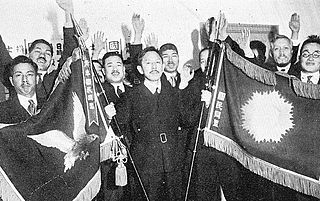
Kokumin Dōmei was a Japanese fascist political party in Japan active in the 1930s.

The Tientsin incident of 1931 was the operation planned by the Kwantung Army of the Empire of Japan to place Puyi on the throne of the Japanese-controlled Manchuria. The plan, orchestrated by Colonel Kenji Doihara and Colonel Itagaki Seishiro was successful, and Puyi became the Chief Executive of Manchukuo the following year. Puyi was subsequently enthroned as the Kangde Emperor in 1934.

Ichizō Kobayashi, occasionally referred to by his pseudonym Itsuō (逸翁), was a Japanese industrialist and politician. He is best known as the founder of Hankyu Railway, the Takarazuka Revue, and Toho. He served as Minister of Commerce and Industry between 1940-1941.

Kenkichi Yoshizawa was a Japanese diplomat in the Empire of Japan, serving as 46th Foreign Minister of Japan in 1932. He was the maternal grandfather of Sadako Ogata, the former United Nations High Commissioner for Refugees from 1991–2001.

Takeru Inukai was a Japanese politician and novelist active in Shōwa period Japan. Also known as "Inukai Ken", he was the third son of Prime Minister of Japan Inukai Tsuyoshi.

The State General Mobilization Law, also known as the National Mobilization Law, was legislated in the Diet of Japan by Prime Minister Fumimaro Konoe on 24 March 1938 to put the national economy of the Empire of Japan on war-time footing after the start of the Second Sino-Japanese War.
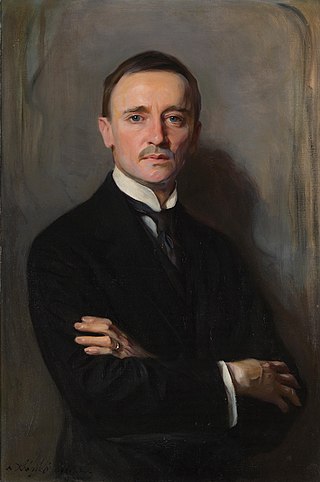
William Richards Castle Jr. was an American educator and diplomat. He rose rapidly to the highest levels of the United States Department of State and took a strong interest in Pacific issues, in part because of his family's background in Hawaii.
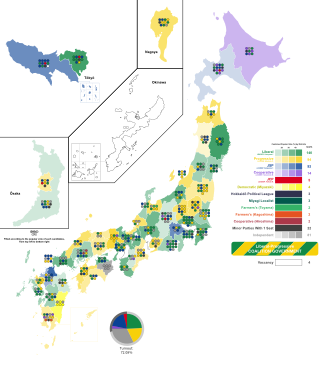
General elections were held in Japan on 10 April 1946, the first after World War II, during the Allied occupation. Voters had one, two or three votes, depending on how many MPs were elected from their constituency. The result was a victory for the Liberal Party, which won 141 of the 468 seats. Voter turnout was 72.1 percent.
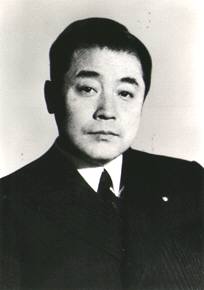
Viscount Keizō Shibusawa was a Japanese businessman, central banker, philanthropist and folklorist. He was the 16th Governor of the Bank of Japan (BOJ).
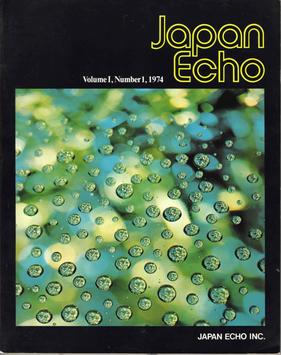
Japan Echo was an English-language periodical on Japanese issues which was initially published in print form by Japan Echo Inc. between 1974 and 2010. Consisting mainly of translations into English of magazine and news articles originally published in Japanese, Japan Echo was launched with the support of Japan's Foreign Affairs Ministry "to enable people abroad to learn what the Japanese themselves are thinking and writing about the issues of the day." Though independently published, the Japanese government provided most of Japan Echo's funding for the duration of its existence.
Events in the year 1951 in Japan.

















